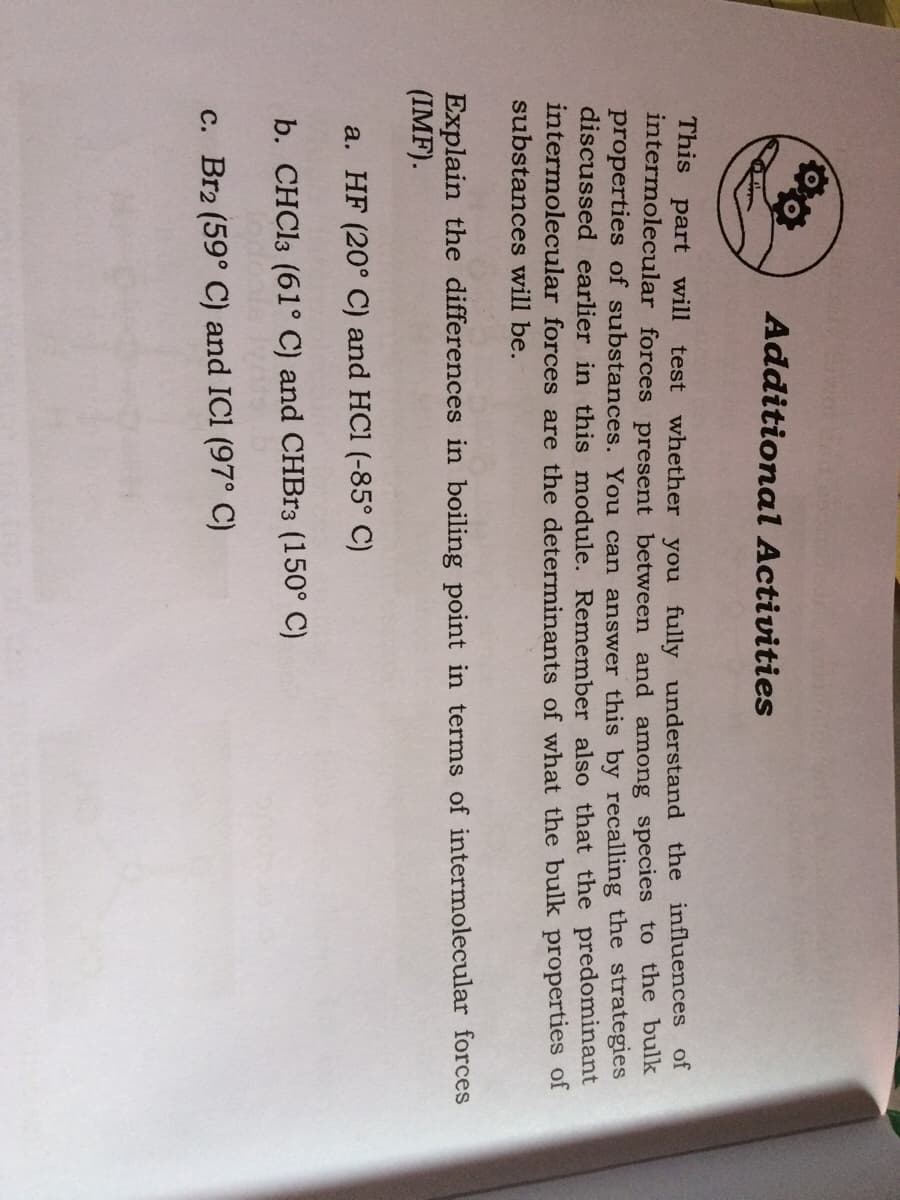Additional Activities This part will test whether you fully understand the influences of intermolecular forces present between and among species to the bulk properties of substances. You can answer this by recalling the strategies discussed earlier in this module. Remember also that the predominant intermolecular forces are the determinants of what the bulk properties of substances will be. Explain the differences in boiling point in terms of intermolecular forces (IMF). a. HF (20° C) and HCl (-85° C) b. CHC13 (61° C) and CHBR3 (150° C) c. Br2 (59° C) and ICl (97° C)
Additional Activities This part will test whether you fully understand the influences of intermolecular forces present between and among species to the bulk properties of substances. You can answer this by recalling the strategies discussed earlier in this module. Remember also that the predominant intermolecular forces are the determinants of what the bulk properties of substances will be. Explain the differences in boiling point in terms of intermolecular forces (IMF). a. HF (20° C) and HCl (-85° C) b. CHC13 (61° C) and CHBR3 (150° C) c. Br2 (59° C) and ICl (97° C)
Chemistry: The Molecular Science
5th Edition
ISBN:9781285199047
Author:John W. Moore, Conrad L. Stanitski
Publisher:John W. Moore, Conrad L. Stanitski
Chapter9: Liquids, Solids, And Materials
Section: Chapter Questions
Problem 116QRT
Related questions
Question
Explain the difference in boiling point in terms of intermolecular forces (IMF)

Transcribed Image Text:Additional Activities
This part will test whether you fully understand the influences of
intermolecular forces present between and among species to the bulk
properties of substances. You can answer this by recalling the strategies
discussed earlier in this module. Remember also that the predominant
intermolecular forces are the determinants of what the bulk properties of
substances will be.
Explain the differences in boiling point in terms of intermolecular forces
(IMF).
a. HF (20° C) and HCl (-85° C)
b. CHC13 (61° C) and CHBR3 (150° C)
c. Br2 (59° C) and ICl (97° C)
Expert Solution
This question has been solved!
Explore an expertly crafted, step-by-step solution for a thorough understanding of key concepts.
This is a popular solution!
Trending now
This is a popular solution!
Step by step
Solved in 3 steps

Knowledge Booster
Learn more about
Need a deep-dive on the concept behind this application? Look no further. Learn more about this topic, chemistry and related others by exploring similar questions and additional content below.Recommended textbooks for you

Chemistry: The Molecular Science
Chemistry
ISBN:
9781285199047
Author:
John W. Moore, Conrad L. Stanitski
Publisher:
Cengage Learning

Chemistry: Principles and Practice
Chemistry
ISBN:
9780534420123
Author:
Daniel L. Reger, Scott R. Goode, David W. Ball, Edward Mercer
Publisher:
Cengage Learning

Chemistry: The Molecular Science
Chemistry
ISBN:
9781285199047
Author:
John W. Moore, Conrad L. Stanitski
Publisher:
Cengage Learning

Chemistry: Principles and Practice
Chemistry
ISBN:
9780534420123
Author:
Daniel L. Reger, Scott R. Goode, David W. Ball, Edward Mercer
Publisher:
Cengage Learning